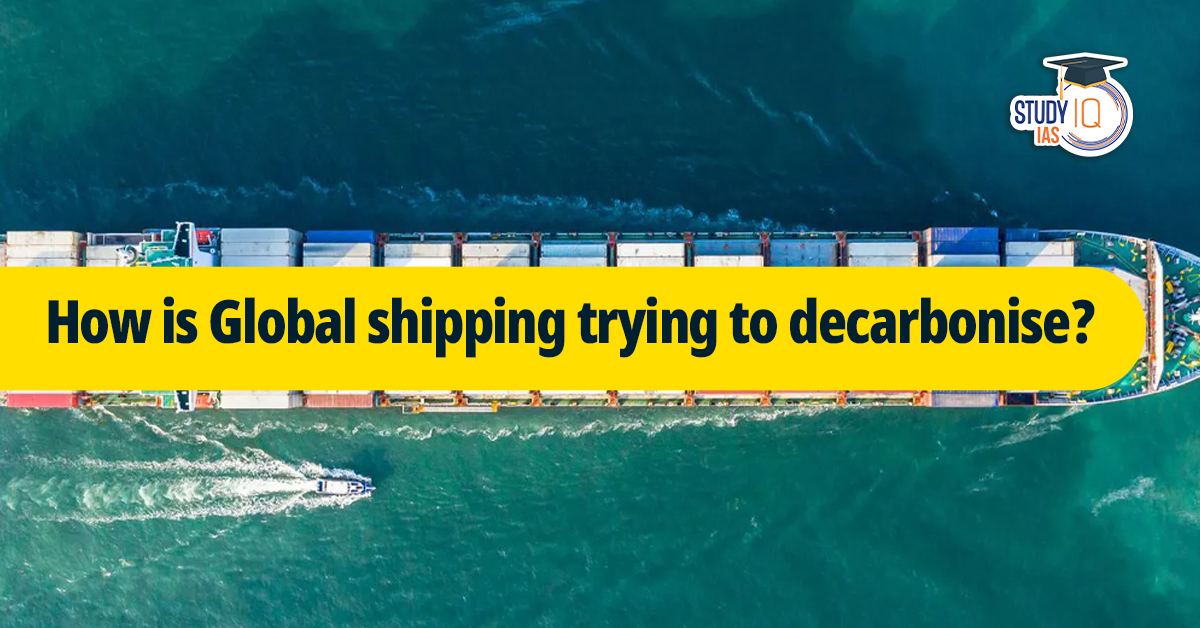Table of Contents
Context: Global shipping targets decarbonisation by 2040–50 by replacing traditional fuels like VLSFO, diesel, and LNG with green alternatives such as green ammonia, e-methanol, and biofuels, creating major opportunities for India in the green energy sector.
Green Fuel Production
- Green hydrogen is made via electrolysis of water using renewable energy.
- For marine use, more stable derivatives are preferred:
- Green Ammonia: Made from green hydrogen and nitrogen.
- Green Methanol: Produced from green hydrogen and captured industrial CO₂.
- India promotes green ammonia to reduce dependence on LNG imports for fertiliser.
Green Methanol as a Transition Fuel
- Green methanol is emerging as shipping’s preferred decarbonisation fuel due to:
- Ease of use
- ~90% lower emissions than traditional fuels.
- Compatibility with existing ship engines (unlike green ammonia).
- Over 360 methanol-ready ships are in use or under construction, supported by Maersk, CMA CGM, Evergreen, etc.
- High costs:
- Green e-methanol = $1,950/tonne (Singapore, Feb 2024)
- VLSFO = $560/tonne
- Cost drivers:
- Needs 10–11 MWh of renewable electricity per tonne.
- High capital cost for electrolyser infrastructure.
- Demand–Supply Gap:
- Demand is projected at 14 million tonnes by 2028, while supply may only reach 11 million tonnes.
India’s Decarbonisation Strategy & Green Fuel Export Plans
- India plans to decarbonise domestic shipping via:
- Promoting green fuel for container ships.
- Developing green fuel bunkering hubs at Tuticorin (VOC Port) and Kandla.
- Plans to export green fuels to Singapore, which manages 25% of global ship fuel demand.
- Leverages its large solar capacity and green tech expertise to emerge as a global green fuel supplier.
Building India’s Green Marine Fuel Hub – Challenges & Solutions
Key Challenges
- Dependence on imported solar panels and electrolysers.
Progress & Solutions
- Solar capacity growth: From 82 GW (2014) to 105 GW (2025).
- Use of sovereign guarantees to reduce borrowing costs via cheaper foreign financing.
- Policy tools like:
- PLI schemes for electrolyser production.
- CCUS (Carbon Capture, Utilisation & Storage)
- Goal: Build local green fuel value chains and reduce CO₂ transport costs.
- The government aims to create 5 GW of electrolyser manufacturing capacity.
- Expand industrial CO₂ sourcing for green methanol.
- Access to low-interest loans (4%) from multilateral development banks vs. 11–12% from domestic lenders.
Reviving Indian Shipbuilding via Green Fuel Push
- India supports shipbuilding and shipowning by:
- Offering demand-side incentives.
- Encouraging foreign collaborations (e.g., with South Korea, Japan).
- Retrofitting old ships and building new green fuel-capable ships.
- Investment:
- Committed $10 billion to build over 110 ships.
- Target: 10–20% of ships to be green fuel-ready, Made in India, and flying the Indian flag.
- Aims to strengthen local shipbuilding while meeting global climate goals.


 List of National Parks in India 2025, Ch...
List of National Parks in India 2025, Ch...
 Bonnet Macaques: Habitat, Features, Beha...
Bonnet Macaques: Habitat, Features, Beha...
 Periyar Tiger Reserve, Map, Flora, Fauna...
Periyar Tiger Reserve, Map, Flora, Fauna...

























